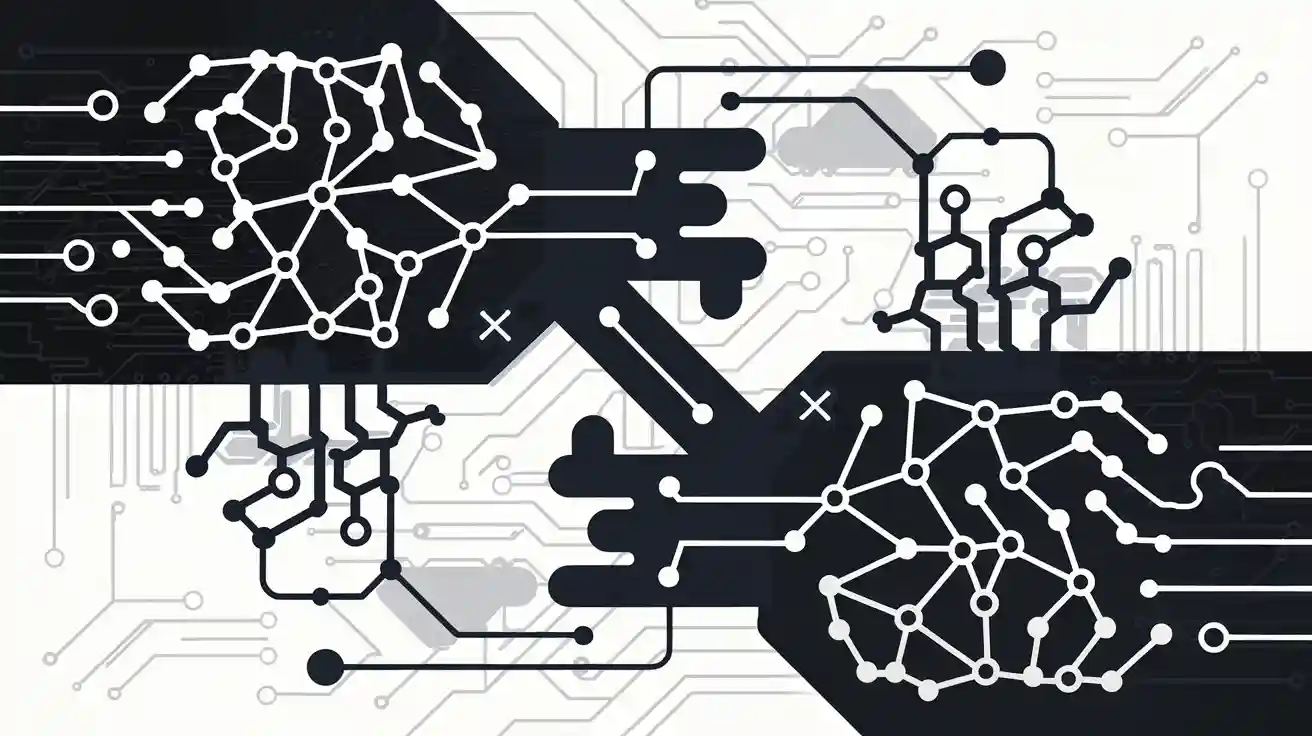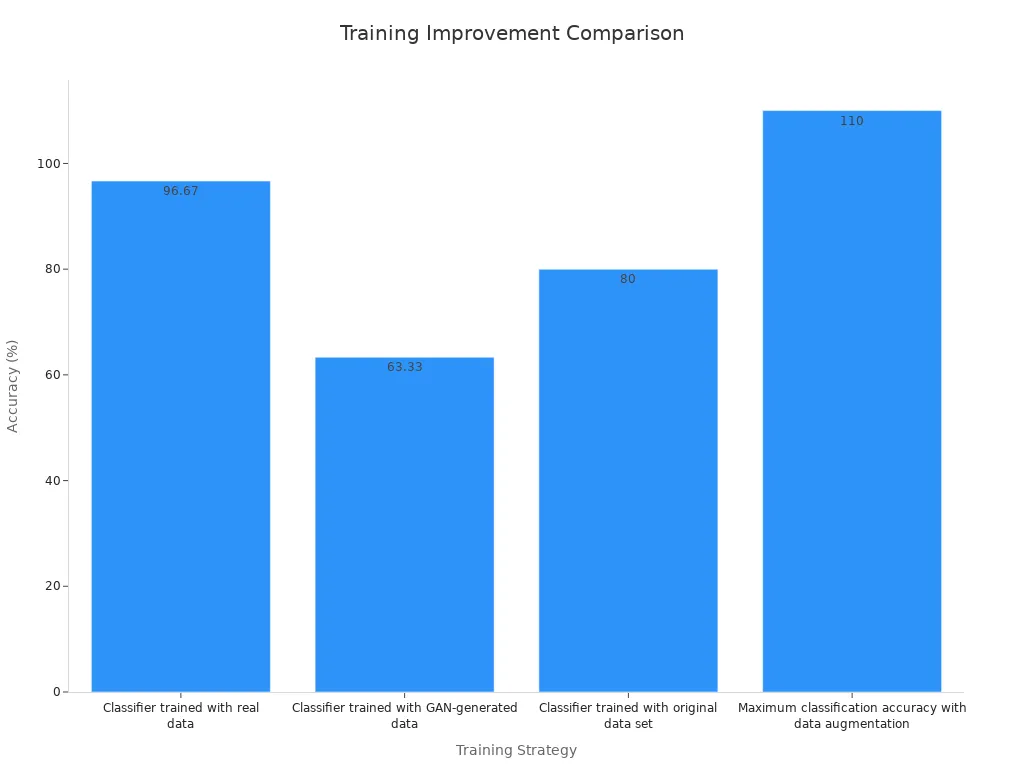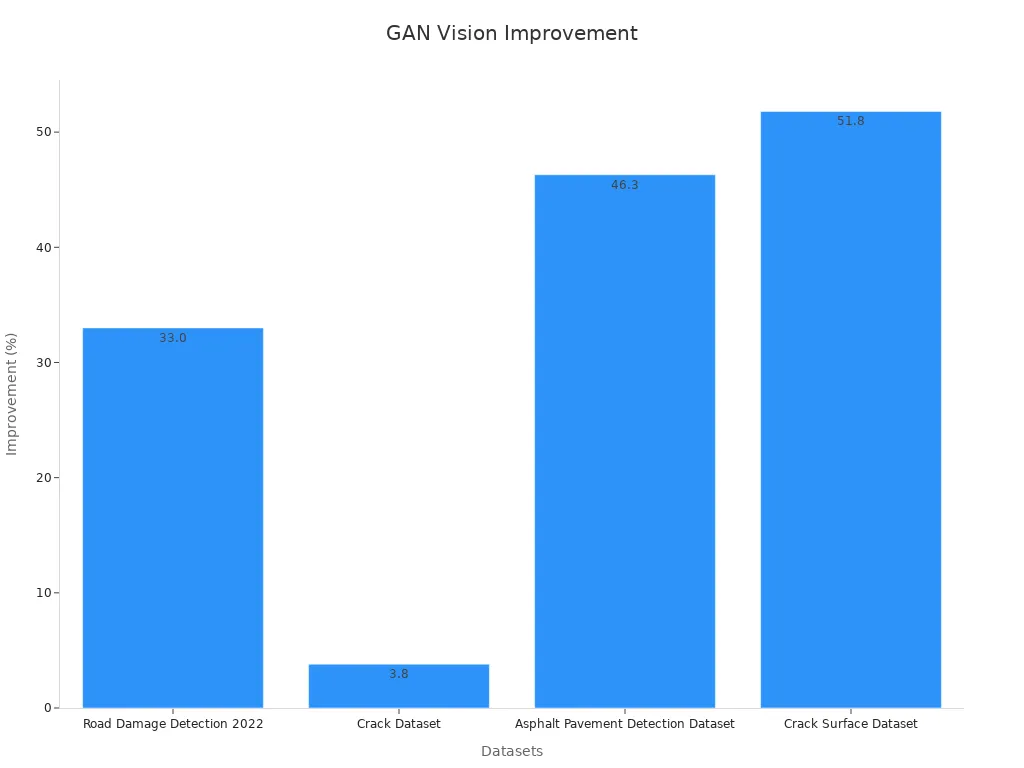Generative Adversarial Networks Explained for Beginners

Generative Adversarial Networks (GANs) are an innovative AI model where two components, the generator and the discriminator, work in tandem to produce highly realistic data. This dynamic interaction forms the foundation of a Generative Adversarial Networks (GANs) machine vision system, with the generator crafting new data, such as images, and the discriminator assessing it to differentiate between authentic and synthetic outputs.
GANs have transformed AI by driving progress across various industries. For instance, they are now integral to machine vision systems, generating high-resolution images and simulating lifelike medical scans to enhance healthcare diagnostics. In the entertainment sector, GANs contribute to creating ultra-realistic visuals, elevating viewer experiences. Additionally, these systems bolster cybersecurity by simulating cyber-attack scenarios, enabling stronger defenses. From finance to healthcare to media, GANs and their machine vision systems continue to redefine the possibilities of AI.
Key Takeaways
- Generative Adversarial Networks (GANs) have two main parts. One part makes data, and the other checks if it’s real or fake. They compete to make better results.
- GANs are useful in many areas. They help doctors with medical pictures, make cool visuals for movies, and test security by pretending to be hackers.
- Training GANs is like a game. One part tries to make fake data look real, while the other gets better at spotting fakes.
- There are different kinds of GANs, like Conditional GANs and Deep Convolutional GANs. These types make GANs more useful for special jobs.
- GANs help improve computer learning by making fake data for practice. This makes models more accurate and saves time collecting real data.
What Are Generative Adversarial Networks (GANs)?
Basic definition of a generative adversarial network
Generative adversarial networks (GANs) are a type of AI model designed to create realistic data by using two systems that compete against each other. These systems are called the generator and the discriminator. The generator produces new data, such as images, while the discriminator evaluates whether the data is real or fake. This adversarial process helps the generator improve over time, resulting in highly realistic outputs.
To better understand GANs, consider the framework proposed by researchers:
| Aspect | Description |
|---|---|
| Framework | GANs estimate generative models through an adversarial process. |
| Models | The generator (G) creates data, and the discriminator (D) evaluates it. |
| Training Process | G tries to fool D, while D aims to identify fake data, forming a minimax two-player game. |
| Unique Solution | A unique solution exists where G perfectly mimics the training data distribution, and D becomes equally uncertain (outputs 1/2 everywhere). |
| Training Method | GANs use backpropagation for training, eliminating the need for complex methods like Markov chains. |
| Experimental Validation | Studies show GANs can generate high-quality samples, validated through both qualitative and quantitative evaluations. |
This structure makes GANs a powerful tool for generating realistic data without relying on traditional methods.
Why GANs are unique compared to other AI models
GANs stand out from other AI models due to their ability to create lifelike outputs and their versatility across applications. Here are some reasons why GANs are unique:
- They generate images that closely resemble real ones, making them valuable for art, content creation, and medical imaging.
- GANs synthesize realistic video sequences, which are useful for film production and virtual reality experiences.
- They enhance learning by augmenting data in scenarios with limited training samples, such as facial recognition tasks.
- GANs produce samples faster than many other models, enabling real-time applications like gaming and interactive environments.
These features make GANs a preferred choice for tasks requiring high-quality, realistic outputs. Their ability to simulate real-world data has revolutionized industries ranging from healthcare to entertainment.
How Do GANs Work?
Understanding how generative adversarial networks function begins with exploring the roles of their two main components: the generator and the discriminator. These systems work together in a unique adversarial process to create realistic data.
The role of the generator
The generator is the creative force behind GANs. It uses a convolutional neural network to produce synthetic data, such as images, that mimic real-world examples. Think of the generator as an artist trying to paint a picture that looks indistinguishable from a photograph. Initially, the generator's creations may appear unrealistic, but it improves over time through continuous feedback from the discriminator.
The generator learns by trial and error. During training, it generates samples and adjusts its methods based on whether the discriminator identifies them as fake. This iterative process helps the generator refine its outputs, eventually producing data that closely resembles the original. For example, in image synthesis tasks, the generator can create lifelike variations of faces, landscapes, or objects.
The role of the discriminator
The discriminator acts as the critic in this system. It uses a deconvolutional neural network to evaluate whether the data it receives is real or generated. By analyzing both authentic and synthetic samples, the discriminator learns to distinguish between the two with increasing accuracy.
You can think of the discriminator as a detective examining clues to determine whether a piece of data is genuine. As the generator improves, the discriminator faces more challenging tasks, pushing it to become better at identifying subtle differences. This dynamic ensures that both components evolve during the training process.
| Component | Description |
|---|---|
| Generator | A convolutional neural network that creates false data to train the discriminator, learning to generate plausible data. |
| Discriminator | A deconvolutional neural network that distinguishes between real and generated samples, using both fake and real data for training. |
How the generator and discriminator interact (the adversarial process)
The interaction between the generator and discriminator forms the heart of GANs. This adversarial process is like a game where the generator tries to fool the discriminator, and the discriminator aims to catch the generator's mistakes.
Here’s how it works:
- The generator creates synthetic samples based on random input data.
- The discriminator evaluates these samples alongside real ones, determining whether they are authentic or fake.
- The generator receives feedback from the discriminator and adjusts its methods to produce more convincing data.
- The discriminator, in turn, refines its ability to detect fake samples as the generator improves.
This back-and-forth process continues until the generator produces data that the discriminator can no longer reliably identify as fake. For example, in image-to-image translation tasks, GANs can transform sketches into realistic images by refining the generator's synthesis techniques.
Over time, this adversarial training leads to remarkable results. GANs can generate high-quality samples that are nearly indistinguishable from real data, making them invaluable for applications like image synthesis, data augmentation, and AI-driven creativity.
Types of Generative Adversarial Networks
Generative adversarial networks come in various types, each designed to address specific challenges or improve performance in unique ways. Let’s explore three popular types: Vanilla GANs, Conditional GANs, and Deep Convolutional GANs.
Vanilla GANs
Vanilla GANs represent the original form of generative adversarial networks. They consist of a generator and a discriminator, both of which are simple neural networks. The generator creates synthetic data, while the discriminator evaluates whether the data is real or fake. These two components engage in a competitive process, improving each other over time.
Vanilla GANs are often used for basic tasks like generating simple images or learning data distributions. However, they can struggle with stability during training, which limits their ability to produce high-quality samples. Despite these challenges, Vanilla GANs laid the foundation for more advanced models.
Conditional GANs (cGANs)
Conditional GANs add a layer of control to the generative process. Unlike Vanilla GANs, cGANs allow you to specify conditions for the data generation. For example, you can instruct the generator to create images of a specific category, such as dogs or cars. This is achieved by feeding additional information, like labels, into both the generator and the discriminator.
This type of GAN is particularly useful for tasks like image-to-image translation. For instance, cGANs can transform black-and-white photos into color or convert sketches into realistic images. By incorporating conditions, cGANs enhance the flexibility and precision of data synthesis.
Deep Convolutional GANs (DCGANs)
Deep Convolutional GANs improve upon Vanilla GANs by using convolutional layers in both the generator and the discriminator. These layers excel at processing visual data, making DCGANs ideal for image synthesis tasks. They produce high-quality images with realistic details and variations.
Empirical evidence highlights the effectiveness of DCGANs in real-world applications. For example:
- Inception Score (IS): A score of 1.074 reflects the quality of generated images.
- Fréchet Inception Distance (FID): A value of 49.3 indicates the realism of the generated samples.
- Structural Similarity Index (SSIM): An average score of 0.31 demonstrates the quality of facial image synthesis.
| Metric | Value |
|---|---|
| Inception Score | 1.074 |
| FID | 49.3 |
| SSIM | 0.31 |
DCGANs are widely used in AI applications, from creating lifelike faces to generating diverse image variations. Their ability to handle complex data makes them a cornerstone in the evolution of generative adversarial networks.
StyleGANs
StyleGANs represent a significant advancement in generative adversarial networks. They specialize in creating high-quality images with remarkable detail and control. Unlike earlier GAN models, StyleGANs introduce a unique architecture that separates the generation process into distinct layers. This allows you to manipulate specific features, such as facial expressions or hairstyles, without affecting other aspects of the image.
The generator in StyleGANs uses a technique called "style transfer" to produce diverse variations of images. For example, you can adjust the "style" of an image to create different lighting effects or textures. This flexibility makes StyleGANs ideal for applications like image synthesis, where precision and creativity are essential.
The discriminator plays a crucial role in refining the outputs. It evaluates the generated samples and provides feedback to the generator, ensuring the images become increasingly realistic. Over time, this adversarial process results in lifelike images that are nearly indistinguishable from real photographs.
StyleGANs have revolutionized fields like art and design. You can use them to create realistic portraits, generate synthetic datasets for AI training, or even design virtual environments. Their ability to produce high-resolution images with fine details has set a new standard for image synthesis in AI.
Wasserstein GANs (WGANs)
Wasserstein GANs address some of the challenges faced by traditional GANs, such as instability during training and mode collapse. They use a different approach to measure the distance between real and generated data distributions, known as the Wasserstein distance. This method provides a more stable and reliable framework for training GANs.
The generator in WGANs focuses on minimizing the Wasserstein distance, which helps it produce realistic samples. The discriminator, often referred to as the "critic" in this context, evaluates the quality of the generated data by estimating this distance. This interaction ensures smoother learning and better generalization capabilities.
WGANs outperform traditional GANs in several ways:
- They consistently produce high-quality samples, even in challenging scenarios.
- Theoretical analysis shows that WGANs provide an upper bound for robustness and generalization.
- Extensive experiments demonstrate that WGANs outperform five baseline GAN models, making them a preferred choice for tasks requiring reliable data synthesis.
You can use WGANs for applications like generating diverse image variations, improving data quality for AI models, and enhancing image synthesis techniques. Their robustness and stability make them a powerful tool in the evolving landscape of generative adversarial networks.
Practical Applications of Generative Adversarial Networks

Generative adversarial networks (GANs) have revolutionized the way you interact with AI. Their ability to create realistic data has opened doors to innovative applications across industries. Let’s explore how GANs are transforming image generation, data augmentation, and 3D modeling.
Generate images (e.g., creating realistic faces)
GANs excel at generating photorealistic images, especially faces. By training on large datasets, GANs learn to produce high-quality images that closely resemble real-world examples. You can see their impact in applications like virtual avatars, movie production, and even personalized marketing.
For instance, advancements in architectures like DCGAN and ResNet-based generators have significantly improved the fidelity and diversity of generated images. These metrics ensure that the images not only look realistic but also capture a wide range of variations.
| Metric | Description |
|---|---|
| Fidelity | Measures how realistic the generated images are compared to real images. |
| Diversity | Assesses the variety of images produced by the generator, ensuring it captures the range of data. |
GANs have also been used to generate images for creative projects. For example, they can create lifelike portraits or transform sketches into realistic images. This capability makes GANs a cornerstone of generative AI applications in art and design.
Tip: When training GANs for image generation, the quality of the dataset plays a crucial role. Carefully curated datasets, such as those scraped from Instagram, can help reduce variability and improve the realism of outputs.
Data augmentation for training AI models
Data augmentation is essential for improving the performance of machine learning models, especially when training data is limited. GANs can generate synthetic data to augment existing datasets, enhancing the accuracy and robustness of AI systems.
For example, classifiers trained with GAN-generated data have shown remarkable improvements in accuracy. The following table illustrates how data augmentation impacts model performance:
| Description | Accuracy | Data Type |
|---|---|---|
| Classifier trained with real data | 96.67% | Real Data |
| Classifier trained with GAN-generated data | 63.33% | Generated Data |
| Classifier trained with original dataset | 80% | Original Data |
| Maximum classification accuracy with data augmentation | 110% | Generated Data |

GANs enable you to generate training data for tasks like facial recognition, object detection, and text-to-image synthesis. This approach reduces the need for costly data collection and ensures that your machine learning models perform well across diverse scenarios.
3D modeling and design
GANs are transforming 3D modeling by enabling the creation of realistic 3D objects. You can use GANs to generate 3D models for applications like video game development, virtual environments, and architectural design. These models are not only visually appealing but also highly detailed, making them suitable for professional use.
For example, GANs can generate realistic 3D objects like furniture, vehicles, or even entire landscapes. This capability is particularly useful for industries that rely on high-resolution image generation and realistic simulations. By leveraging GANs, you can reduce the time and effort required to create complex 3D designs.
Generative AI applications in 3D modeling also extend to augmented reality (AR) and virtual reality (VR). GANs help create immersive environments that enhance user experiences in gaming, training simulations, and interactive storytelling.
Note: GANs are not limited to visual data. They can also generate 3D models based on textual descriptions, bridging the gap between text-to-image and 3D design.
Video game development and virtual environments
Video game development has reached new heights with the integration of GAN technology. These networks enhance creativity and efficiency, allowing developers to produce immersive and dynamic gaming experiences. Here’s how GANs are transforming this industry:
- Character and Environment Design: GANs simplify the creation of detailed 3D models. They help designers generate lifelike characters and intricate environments, reducing the time and cost of manual modeling. For example, GANs can create realistic textures for landscapes or unique character designs that adapt to a game’s theme.
- Procedural Content Generation: GANs dynamically generate game levels, items, and scenarios. This ensures players encounter fresh and unique experiences every time they play. Developers no longer need to manually design every element, which saves significant resources.
- Game AI: GANs improve artificial intelligence in games by adapting to player behavior. This creates opponents that are more challenging and unpredictable, enhancing the overall gaming experience.
By leveraging GANs, you can create games that feel more alive and engaging. Players benefit from richer visuals, smarter AI, and endless possibilities for exploration.
Enhancing generative adversarial networks (GANs) machine vision systems
Machine vision systems rely on accurate data to perform tasks like object detection and image recognition. GANs play a crucial role in enhancing these systems by generating high-quality data and improving their learning capabilities. Here’s how GANs contribute to this field:
- Improved Training Data: GANs generate synthetic data to augment existing datasets. This helps machine vision systems learn from a broader range of examples, improving their accuracy. For instance, GANs can create diverse images of road conditions, which are essential for training autonomous vehicles.
- Enhanced Detection Accuracy: By refining the quality of training data, GANs significantly boost the performance of machine vision systems. The table below highlights improvements in detection accuracy across various datasets:
| Dataset | Improvement (%) |
|---|---|
| Road Damage Detection 2022 | 33.0 |
| Crack Dataset | 3.8 |
| Asphalt Pavement Detection Dataset | 46.3 |
| Crack Surface Dataset | 51.8 |
- Real-World Applications: GANs enhance machine vision in industries like transportation, healthcare, and manufacturing. For example, they help detect defects in products, identify cracks in infrastructure, and analyze medical images for early diagnosis.

By integrating GANs into machine vision systems, you can achieve higher accuracy and efficiency. These advancements pave the way for smarter AI solutions in critical industries.
Generative adversarial networks (GANs) have redefined artificial intelligence by enabling two systems to collaborate and create realistic data. Their applications, from generating lifelike images to enhancing machine learning models, have revolutionized industries like healthcare, entertainment, and design.
Looking ahead, GANs hold immense potential to transform AI further. Advancements in research are improving their accuracy and efficiency. The growing demand for synthetic data in healthcare and retail, along with applications in medical imaging and personalized treatment, highlights their future impact. Emerging uses, such as AI-generated product recommendations and integration into the metaverse, also showcase their versatility.
| Year | Market Size (USD Billion) | CAGR (%) |
|---|---|---|
| 2024 | 5.52 | N/A |
| 2030 | N/A | 37.7 |
As GANs evolve, they will continue to push the boundaries of creativity and innovation, shaping the future of artificial intelligence.
FAQ
What is the main purpose of GANs?
GANs aim to create realistic data by training two systems, the generator and the discriminator, to compete. This process helps the generator improve its ability to produce lifelike outputs, such as images, videos, or text.
Are GANs only used for image generation?
No, GANs have many applications. You can use them for video generation, 3D modeling, data augmentation, and even creating music or text. Their versatility makes them valuable across industries like healthcare, entertainment, and design.
How do GANs differ from other AI models?
GANs stand out because they generate new data instead of just analyzing existing data. The adversarial process between the generator and discriminator allows GANs to create outputs that closely mimic real-world data.
Can beginners learn to work with GANs?
Yes! Start by understanding basic neural networks and Python programming. Tools like TensorFlow and PyTorch offer beginner-friendly libraries for building GANs. Online tutorials and courses can also guide you step by step.
What challenges do GANs face?
GANs often struggle with training stability and mode collapse, where the generator produces limited variations. Researchers continue to develop techniques, like Wasserstein GANs, to address these issues and improve performance.
Tip: Experimenting with pre-built GAN models can help you learn faster and avoid common pitfalls.
See Also
The Impact of Generative AI on Manufacturing's Future
A Comprehensive Guide to Deep Learning Fundamentals
Utilizing Synthetic Data to Enhance Machine Vision Technology
Transforming Machine Vision with Innovative Neural Network Frameworks
Is Neural Network Machine Vision Capable of Replacing Humans?
